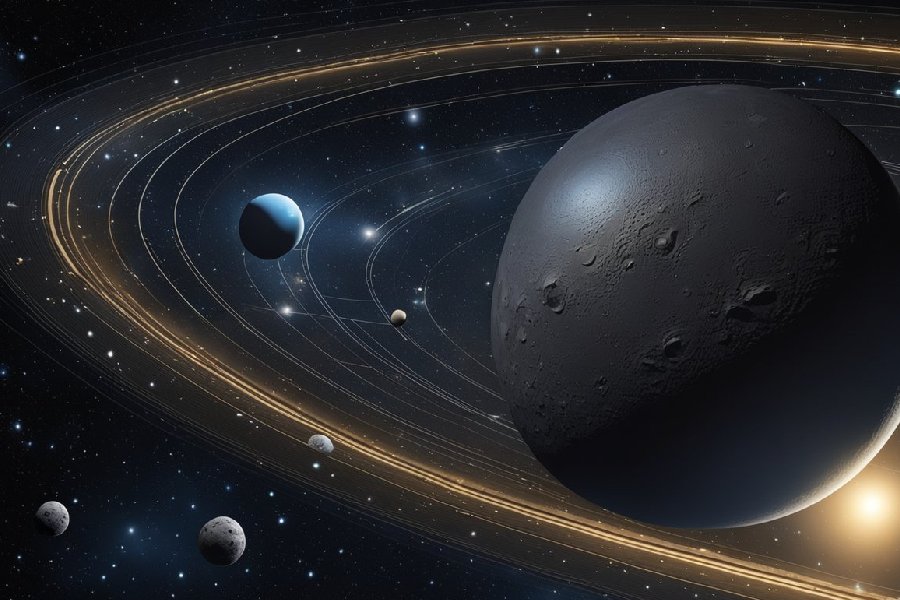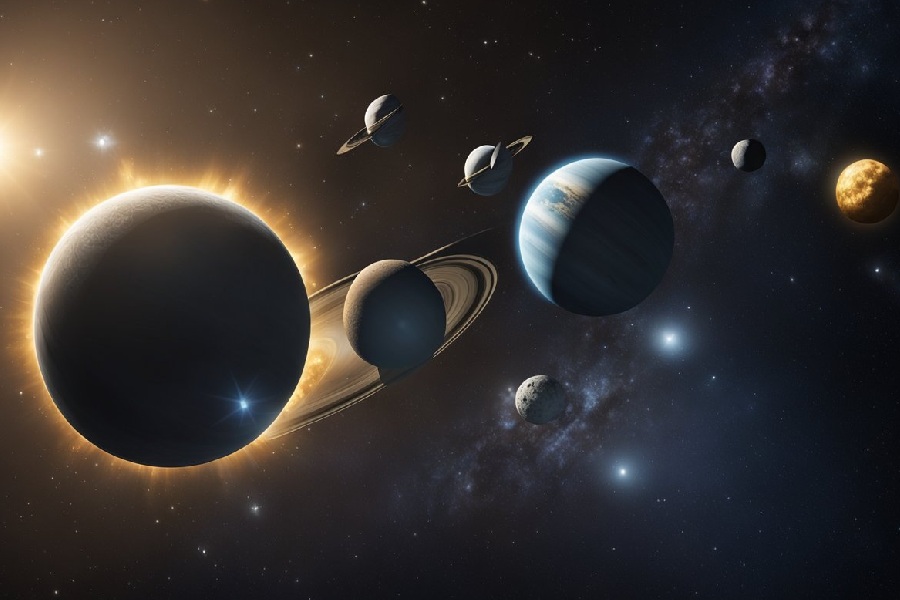Beyond the farthest reaches of frigid Neptune lies a mysterious realm – the Kuiper belt. This donut-shaped zone encircling our Sun contains frozen remnants left over from our Solar System’s birth over four billion years ago, as well as bodies that never coalesced into fully-formed planets.
Known for hosting Pluto and providing the likely origins for most short-period comets observed from Earth, the intricacies of this distant celestial junkyard still reveal new surprises about our cosmic neighborhood’s past and evolution with every probe sent for investigation.
But where is the Kuiper belt located relative to our inner Solar System and familiar worlds? Embark on a tour across the outer limits of our Sun’s planetary family to uncover where this scientifically invaluable belt resides.
Learn how its remote location shaped the Kuiper belt’s history and what future exploration might still unveil about our cosmic ancestry in this vast expanse nearly 20 times further out than Earth’s orbit.

Where Is the Kuiper Belt Located?
Where is the Kuiper belt located? The Kuiper belt is located in the outer region of our Solar System, extending beyond the orbit of Neptune.
It is a vast and distant disc-shaped region composed of icy bodies, dwarf planets, and other small celestial objects. The Kuiper belt is considered a reservoir of primitive bodies that provide insights into the early Solar System’s formation and evolution.
The Kuiper belt’s specific location
Where does the Kuiper belt begin?
The Kuiper belt resides over 19 AU beyond Neptune’s orbit. One astronomical unit is the average span between Earth to the Sun. So at 30 to 55 AU from our star, the Kuiper belt occupies a vast realm four times farther out than Neptune. It marks the point where gas thinned around the new Sun, preventing more planets from forming.
How far is the Kuiper belt from the Sun
In miles, the Kuiper belt begins 2.8 billion miles from the Sun. And it stretches nearly two billion more miles further out at its distant edge.
Crossing such distances would take human spacecraft over a decade in ideal trajectories, highlighting why robotic probes remain necessary. However, NASA eyes potential moon mission technology to reach asteroids one day in the 2030s.
Reservoir of icy objects
The Kuiper belt holds leftovers from the early solar nebula gas cloud. Many bodies reside in this region, preserved in their primordial ultra-frozen states for over four billion years, serving as largely untouched fossils shedding light on original formation dynamics in the pioneering phases of our system architecture.
Most Kuiper belt objects feature highly diverse combinations of frozen methane, ammonia, water ice, carbon dioxide, and carbon-rich compounds. Collisions between bodies likely facilitated chemical alterations across different zones over time.
Disrupted materials in the belt may have even seeded atmospheres and life-essential organics to inner worlds like Earth through meteoroid transport mechanisms.
The Origin of Comets – A Place in Space
Comet origins
Comets are remnants of early system material mostly composed of rock, dust, ammonia, methane, and water ice. Most orbit the Sun in highly elliptical trajectories from two cold storage breeding grounds – the more nearby Kuiper belt and distant, spherical Oort cloud enveloping our Solar System.
The majority of the short-period or ecliptic comets witnessed passing through our inner Solar System during predictable cycles originate from within the relative vicinity of the Kuiper belt’s dislodged debris.
Comet classifications
The Oort cloud is theorized to give rise to long-period comets following eccentric, elongated routes before occasionally falling star-ward.
Identifying the precise source regions of new comets helps classify origins and map early Solar System architecture. Analyses suggest Kuiper belt comets feature higher quantities of frozen water locked inside. Meanwhile, long-period Oort cloud comets contain more rocky dust elements.
Studies propose Kuiper belt comets have more frozen water internally. In contrast, long-period comets from the Oort cloud feature higher levels of rocky dust components. This provides clues into their formative years.
Kuiper Belt, Comets, and Dwarf Planets
Interconnected celestial dynamics
The Kuiper belt serves as a kind of “celestial nursery” occupying a pivotal middle ground niche in our Solar System’s architecture.
It resides between the inner worlds’ domain and the true outer realms. The outer realms are personified by the remote Oort cloud and deep space. The Kuiper belt dynamically links all these regions.
The Kuiper belt acts as the primary source of many short-period comets originating from just beyond Neptune. Comets get dislodged by collisions and gravitational tugs, starting fresh orbits diving Sun-ward on looped trajectories.
The Kuiper belt also classifies as the long-term home for notable dwarf planets like Pluto and Eris that dwell among smaller icy bodies in the trans-Neptunian zone.
Dwarf planets mark a transitional middle ground between asteroids and terrestrial planets in size and mass. The Kuiper belt represents an outer nursery for such sizable frozen worlds taking shape early on.

History of the Kuiper Belt
Gerard Kuiper and the 1950s theory
Biographical overview
Gerard Kuiper was a prolific 20th-century astronomer. He studied atmospheres, surfaces, and moons across the Solar System. Kuiper also helped establish modern planetary science as a formal discipline during his career.
Exploring Kuiper’s contributions to the theory of the Kuiper belt during the 1950s
In the 1950s, Kuiper theorized a reservoir of small icy bodies beyond Neptune’s orbit was needed to explain comets’ origins. He proposed that region, known today as the Kuiper belt before technology allowed actually observing it.
Theoretical framework
Kuiper suggested that a disk-shaped zone past Pluto should contain thousands of icy planetesimals left over from accretion. This provided a theoretical source for some observed comets as these small frozen worlds were occasionally disrupted towards the Sun.
Though not directly observed until 1992, Kuiper’s pioneering theoretic work framed the understanding of comets and outer Solar System formation for decades.
It guided searches, eventually discovering Pluto’s neighbors and New Horizons’ mission targets. The Kuiper belt’s namesake honors Kuiper’s breakthrough proposals.
Structure of the Kuiper Belt
Basic structure of the Kuiper belt
The Kuiper belt forms a thick donut shape aligned to the plane where planets orbit. It spans semi-major axes, tilting only about two degrees off from the ecliptic. The main Kuiper belt lasts from 30 AU out towards 50 AU at the densest points. Density patterns split it into distinct zones.
Notable features or patterns within this celestial region
Several groupings exist inside the broader Kuiper belt – the resonant belt locked in orbital harmonies with Neptune, the scattered disk with highly elliptical orbits, and detached objects like Sedna in very distant isolated ranges. These structure patterns offer clues into formative mechanisms and migration histories of bodies.
The classical Kuiper belt concentrated between 42-48 AU shows a sharp outer edge suggesting gravitational sculpting interactions with an unidentified massive perturber in the early Solar System steering smaller objects.
One hypothesis proposes an ejected early giant planet. One day, far-flung surveys may reveal this proposed “Planet Nine”.
Trans-Neptunian Objects (TNOs)
Trans-Neptunian Objects or TNOs are celestial bodies in stable orbits beyond Neptune out towards the Kuiper belt’s periphery. Studying this diverse population unveils clues about early accretion phases in the outermost Solar System over four billion years ago.
Different types of TNOs and their characteristics
Major TNO types exhibit distinct traits reflecting formative mechanisms. Classical TNOs reside in the main concentration of the belt. Scattered TNOs were propelled to highly elliptical orbits from past gravitational unrest.
Detached TNOs float extremely distant in very elongated looping routes lasting thousands of years like Sedna. Resonant TNOs orbit in synchronistic patterns governed by orbital resonance factors with Neptune, like Pluto.
Dwarf planets are TNOS reaching equilibrium into rounded spheres under gravity while lacking enough mass for planetary clearing of orbits – Pluto, Eris, and Makemake all fall under this TNO designation. Differentiating them informs models on Solar System evolution.
Conclusion
By now, you understand that the Kuiper belt occupies a vast, donut-shaped realm beyond Neptune, some 30 AU from our Sun. Reviewing its precise Solar System placement reveals the sequencing of our local celestial neighborhood.
Gaining familiarity with the Kuiper belt’s structure and contents facilitates contextualizing exciting new discoveries from Arrokoth (Ultima Thule) and future robotic emissaries to this region.
As we discover objects in the Oort cloud and welcome comets from the Kuiper belt, we unravel the mysteries of their origins. Understanding where is the Kuiper belt located, our own interwoven cosmic ancestry peering back from the mirror of space-time will come into focus.
